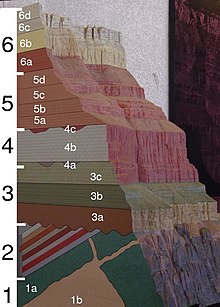
Back تكوين جيولوجي Arabic Formación xeolóxica AST Formació geològica Catalan Souvrství Czech Formation (geologi) Danish Formation (Geologie) German Σχηματισμός (γεωλογία) Greek Geologia formacio Esperanto Formación geológica Spanish Kihistu Estonian

A geological formation, or simply formation, is a body of rock having a consistent set of physical characteristics (lithology) that distinguishes it from adjacent bodies of rock, and which occupies a particular position in the layers of rock exposed in a geographical region (the stratigraphic column). It is the fundamental unit of lithostratigraphy, the study of strata or rock layers.[1][2]
A formation must be large enough that it can be mapped at the surface or traced in the subsurface. Formations are otherwise not defined by the thickness of their rock strata, which can vary widely. They are usually, but not universally, tabular in form. They may consist of a single lithology (rock type), or of alternating beds of two or more lithologies, or even a heterogeneous mixture of lithologies, so long as this distinguishes them from adjacent bodies of rock.[1][2]
The concept of a geologic formation goes back to the beginnings of modern scientific geology. The term was used by Abraham Gottlob Werner in his theory of the origin of the Earth, which was developed over the period from 1774 to his death in 1817.[3] The concept became increasingly formalized over time and is now codified in such works as the North American Stratigraphic Code and its counterparts in other regions.[4]
Geologic maps showing where various formations are exposed at the surface are fundamental to such fields as structural geology, allowing geologists to infer the tectonic history of a region or predict likely locations for buried mineral resources.[5]
- ^ a b Boggs 1987, pp. 545–547.
- ^ a b North American Commission on Stratigraphic Nomenclature 2005, pp. 1567–1569.
- ^ Frank 1938, pp. 221–222.
- ^ North American Commission on Stratigraphic Nomenclature 2005.
- ^ Ghosh 1993.